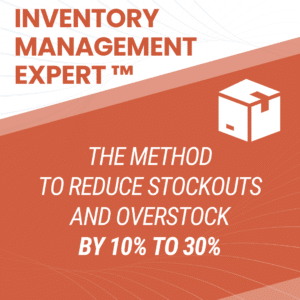Here are the 10 most common mistakes in inventory management, supply chain, and supply chain management. Together we will see how to identify and avoid them.

1) The lack of control of the product catalog
This is the most common and yet the most obvious mistake. Not having an Excel file or tool that centralizes 100% of the company’s products and includes all the key information for inventory management. I mean 100% of the products, i.e. the obsolete products with stock, active products but also new products referenced without stock.
This document must be composed of :
- Product tree (categories, family, product type)
- Reference number
- Product name
- The product status (new or not)
- Purchase price
- Supplier lead time
- Minimum Order Quantity (MOQ)
- Catalog sale price
- Actual sale price
- Product end date
- Margin
- Past sales (52 weeks, 4 weeks, 1 week) in quantity and value
- Current stock in quantity and value
- Average stock coverage
Ideally, you can include :
- End of life date of the product
- Forecasts of future sales
- Average past stock
- Reference product (similar old product).
- The photo of each product
This catalog is the basis for efficient inventory management. All the companies in which I have worked have strongly neglected this first point. I strongly recommend that you spend time on it, check it and update it regularly.
2) No Supply Chain KPIs or too many Supply Chain metrics
You can’t progress without measuring the performance of your inventory management and supply chain. That’s why I recommend that you implement at least 2 simple indicators: Customer availability rate and Stock life expectancy.
You can add the forecast quality and the % of delivery on time of your suppliers if your company manages many quantities, but be careful not to over-complicate your animation.
One of the companies I worked for had about ten supply chain indicators. These intermediate indicators were used more to animate a “war” between the different departments of the company to know who was right or wrong, rather than to focus on the 2 priorities that each company must have:
- Guarantee your customers’ satisfaction with the availability of your products…
- … while guaranteeing the most profitable and low stock possible.
Go Further: Read our post 10 Supply Chain KPIs
3) Focus only on the purchase price
Buying your products as cheaply as possible from your suppliers is very important, but it is a serious mistake to focus only on the purchase price. It is always necessary to have a complete cost approach, very often called “TCO”: Total Cost of Ownership.
Here is a list of criteria to consider :
- Purchase price.
- Supplier lead time.
- Minimum order quantity (MOQ)
- Supplier reliability.
- Product quality (% of defective products).
- Supplier service.
- Ease of communication with the supplier.
- Payment lead time.
- Dependence of the supplier on your activity.
- Flexibility and elasticity of the supplier.
- Uncertainty of your sales forecast.
- The life span of your products.
- etc…
Some of these criteria are easily measurable (price, payment term), others much less so (reliability, sales uncertainties). The important thing is, at least at the beginning, to have a full cost approach. If the choice between two suppliers is difficult, give priority to customer satisfaction.
I have worked for several years on Excel tools to estimate full cost profitability, particularly on procurement choices in Asia vs Europe. I am currently writing an article dedicated to full cost inventory management.
If you would like to have a first experience with these inventory management Excel tools, do not hesitate to contact us
4) Manage your inventory manually
Another classic! For fear of missing and not controlling, many companies have a very manual approach to their stock. Again, this is a mistake.
Several scientific studies* have shown that orders placed by “humans” are generally too high for fear of missing out. This behavior varies according to the personality of each person (conservative vs. overconfident), but the main problem with manual controls is that they are not rational enough due to the lack of analysis and time.
This is why it is recommended to manage your orders with an automatic calculation on Excel or an ERP.
On the other hand, “humans” are much better than mathematical formulas in the event of exceptional events such as commercial transactions, calendar shifts, promotions, etc.
That’s why I recommend leaving only 95% of your orders automated and manually managing only controls and exceptions. This will give you more time to take care of your customers and teams.
*For the most motivated, I recommend the publication of the MIT on warehouse order automation for the Zara group. I have had the opportunity to work with them on these issues.
Zara Uses Operations Research to Reengineer Its Global Distribution Process
5) Too many storage sites
A storage point can be a warehouse, a store, a reserve… The more storage points you have for the same product, the more you mechanically increase your inventory without necessarily improving the level of service. Even in a store, having a stock reserve in addition to your shelf stock can mechanically increase the total stock by 10 to 50%!
For what reasons? There are 4 :
- The storage unit is very often more than 1 piece (cardboard, pallet…), it mechanically increases the stock coverage on all storage points
- More storage points = more complex inventory management = more management error
- Incorrect stock distribution in case of shortage
- No display of the total stock.
It is for these reasons that it is strongly recommended to centralize as much as possible your stock, especially on your low sales. Decentralization of stocks is only recommended for very long lead times, for products with high sales volatility (not predictable) and a very high transport cost share in the final cost of products, especially for large products.
6) Same stock coverage/safety stock on all products
Let us take a concrete example here. I worked for a long time in a company that sold sports goods, especially textiles (well known in Europe).
In your opinion, should you have as much stock coverage on pink 4XXXL shorts as on basic black shorts? Of course not, of course not. The risk of overstocking is much higher on a very low sale, especially if it is a limited edition.
Even on these pink shorts, the level of coverage should be different between central and extreme sizes. Unfortunately, due to lack of time and method, inventory management is too often averaged and we always end up being out of stock on the references we sell the most, and over-stock on low sales.
To quickly manage different levels of coverage, I recommend a full cost and Pareto approach:
1 – Set up an ABC analysis at the smallest level to focus your stock on your best-selling references (in the example, the size of the shorts, not the model).
2 – Identify your profitable or risky references. You can use the margin level if you don’t have time to go into detail.
3 – Apply a simple Excel formula, which, depending on the code A, B or C, the risk and the margin level, will automatically change the coverage. If you are not working on Excel, you can then upload your settings to your ERP.
Go Further::
7) Neglect new products forecast
The implementation order (new product order), i. e. the first order you place with your supplier for a new product can represent on average 30/40% of the annual quantity but can increase up to 80% or even 100% for limited editions. However, the calculation of this quantity of implantation is too often neglected.
A good implementation order is based on :
- Sales histories on a similar model
- Supplier delay
- Minimum order quantity (MOQ)
- Stock coverage in addition to supplier delay
- A level of win/lose risk based on margin and stock cost
8) Too much space in your warehouse
It is well known that nature hates emptiness. The more space you have, the more you settle in, the less demanding and vigilant you are about your stock.
It’s exactly the same in his house or apartment. If you live in a 20 m2 area, you are not going to buy a new rower or a table tennis table. You only live with the essentials, the rest is comfort and superfluity. When it comes to inventory management, we don’t want anything superfluous. To be effective, you must be under constant pressure.
Toyota factories are worldwide known for leaving no room for stock. The size of the plants is much smaller than the average of their competitors because, in the plans, there are almost no storage points. Everything is just-in-time, which requires maximum inventory optimization. On some parts, they only have a few hours of inventory… This makes it possible to adapt demand very quickly, to considerably reduce financial and logistical costs and to quickly identify defective parts.
Ask yourself the question: what is my current filling rate (in % of m^3 or m^2)? Beyond 85%, the logistics process may be less efficient, but this will force you to optimize your inventory.
9) Work far from your warehouses and inventory
In the same way, as when you have too much space, it is a matter of staying efficient and not comfortable. The best supply chain companies in the world work beside their Inventory, or even in the middle of their stock. Working on Excel lines does not replace the visual aspect.
One company I worked for had nice offices in the city center while its warehouse was outsourced on the outskirts. It was necessary to drive 2 hours by road (one way – without traffic jams) to visit the warehouse. I might as well tell you that the visits were not frequent.
Not seeing your inventory regularly can disconnect you from reality and make you realize that you have too much stock, especially on your slow-moving inventory. It is difficult to measure the importance of this criterion, but if you have a choice, do not fall into comfort and work next to your inventory. If this is not the case, plan regular and planned visits with your teams in advance to keep in touch.
10) Too many software and IT tools linked to your inventory management
This is one of the main causes of poor inventory management over the past 20 years. Due to the lack of a global solution on the market, many companies use a lot of different software and tools to operate: software for the Catalog of Products, software for accounting, software for inventories, software for suppliers, a tool for quality, a tool for prices and margins, marketing… These examples speak for themselves. In the end, we no longer know where to find reliable information and the inventory management that works with all the company’s departments is the main impact.
In recent years, many global IT solutions have come to market and many companies are leading digital transformation projects to reduce their number of tools and have a single data set. In particular, I worked for several years as a supply chain project manager and we “migrated” all inventory management processes to SAP, a world-renowned ERP.
These migration projects are extremely expensive and can take several years (even 5 to 10 years for multinationals). But in the long term, they will give you a considerable competitive advantage, because it is data management (also called big data) that will allow you to better manage your stocks, but also to better know your customers, better choose your offers, your prices…
My last recommendations
1 – Plan as soon as possible to migrate to a single data management software, such as ERP, at least on inventory management. If your business is still small, the longer you wait, the more expensive and risky it will be. You can use the ERP Software page to help you choose your ERP and inventory management software.
2 – In the meantime, centralize all your data on an Excel (see article “product catalog”), taking care to automate as much as possible the data extraction process to avoid manual operations.
Personally, I develop Excel macros to automatically retrieve, transform and copy and paste all data. It only takes me a few minutes a week without any possible mistakes. Do not hesitate to contact us if you need support to automate your process and Optimize your Inventory Management.
Go Further: 10 WAYS TO OPTIMIZE YOUR INVENTORY






